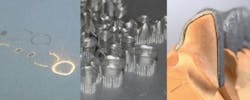Laser sintering high-quality dental components
Cologne, Germany – Here at this year’s International Dental Show, EOS, a supplier of laser sintering systems, will be showcasing advanced e-Manufacturing solutions for dental crowns, bridges and implants. This digitalized manufacturing workflow based on laser sintering technology enables substantial time savings as well as parts that are characterized by excellent mechanical properties, a constant quality, and a high detail resolution.
Dental restorations have long been conventionally produced primarily from metal through the use of casting techniques. Currently, though, dental technology is undergoing a radical shift and a process of industrialization that has already taken place in other markets. Today, the use of digital dental technology is on the rise and manufacturing processes are being automated. Using the conventional casting production process, a dental technician can currently produce only about 20 dental frames per day. Laser sintering is a significantly superior method: one fully automated laser sintering system can produce approximately 450 high-quality units of dental crowns and bridges within 24 hours. This corresponds to a production speed of approximately three minutes per unit on an average, making laser sintering a true industrial process ensuring high productivity at a reduced cost.
By digitalizing the work steps, it is possible to weed out error sources from the assessment of the patient to the production in the lab and to guarantee consistent high quality. This reduces the risk of incorrect preparation or moldings, of imprecisions in fit as well as during the finishing work, and costly repetitions. Digital in data generation, laser sintering at the same time enables a high reproducibility of production properties and a patient-specific serial production. At the same time, this technology is much more cost effective than conventional precision casting. As such, the software supported workflow enables reduced processing times, permitting the dental technician to concentrate on the vital peripheral processing steps of value creation such as aesthetic and function-orientated ceramic veneering.
In order to manufacture dental restorations based on this additive manufacturing method, the 3D CAD data is sliced into layers. The system runs with an Ytterbium-fiber laser with a nominal output of 200 W. The desired geometry of dental crowns or bridges is produced in layers by selectively fusing metal powder and with the possibility of integrating identification tags. After production has been completed, supports can easily be removed. Since operating a DMLS system requires personnel only for loading and unpacking the machine, two production cycles per day can be executed. Currently, EOS has an installed base of more than 35 dental systems worldwide.
For the manufacture of dental crowns and bridges, the EOSINT M 270 processes a special cobalt chromium molybdenum-based super alloy, EOS Cobalt Chrome SP2. It is biocompatible and CE certified for use in the dental industry (CE 0537). This well-established material has seen considerable demand in recent years and is very inexpensive compared to precious metal alloys. The quick solidification after melting leads to a fine and homogenous microstructure whereas during the casting there is always a risk of overheating and segregation.
EOS, founded in 1989, employs 300 people worldwide, 250 of them in Krailling near Munich, Germany.

